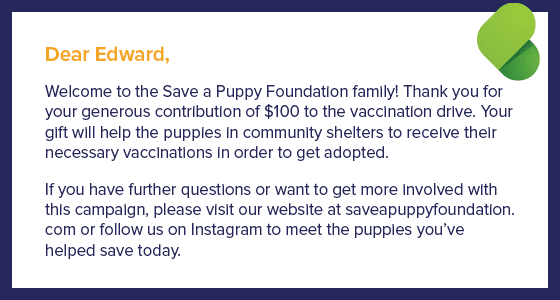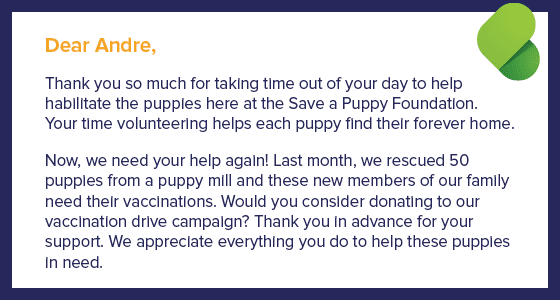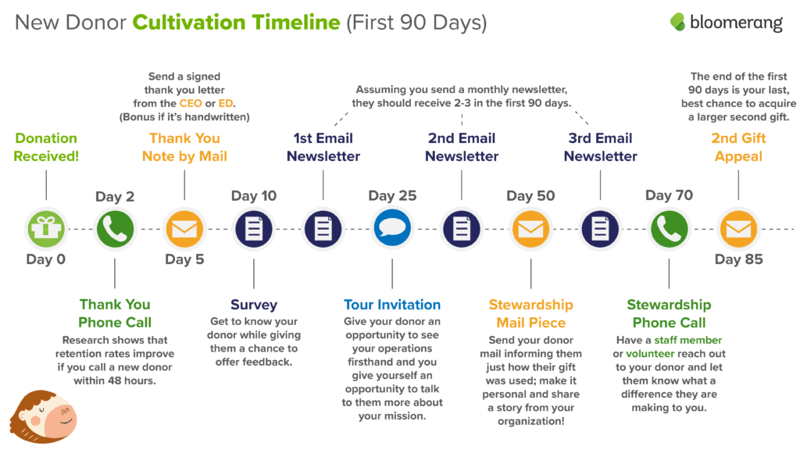Maintaining strong donor relationships is the key to fundraising success. If you don’t build relationships with your supporters, you’re flushing all sorts of potential retained funds down the toilet. That’s because it’s much more expensive to acquire new supporters than it is to retain the ones you already have. Plus, when supporters stay engaged with your organization over time, they’re more likely to donate more money as time goes on.
That’s why you should be continuously refining the way you reach out to your supporters in your donor database, constantly improving and personalizing your messages to engage them and encourage them to continue giving for a long time to come.
Just increasing your donor retention rate by 10% can make a huge difference in the amount of revenue your organization can generate over time. For example, consider the following image:

In this example, the nonprofit was able to save $456,349 just by increasing their donor retention rate by 10%, which put their rate above the average industry rate of 41%.
In this guide, we’ll provide the tools, tips, and strategies that you need to deepen donor relationships, in turn allowing you to also increase your retention rate. We’ll cover ways that you can:
Especially in a time when social distancing and restricted in-person interactions have limited engagement strategies for nonprofits, developing concrete relationship-building tactics is essential for your organization. Take into account the shift to virtual events and digital fundraising strategies and the hesitation some supporters may have to attend in-person opportunities to support your nonprofit, ensuring you appeal to everyone’s comfort levels.
1. Personalize interactions.
If you receive a letter in the mail that starts off with the salutation, “Dear valued supporter,” how likely is it that you’ll continue reading? It’s likely that you won’t read past the first line. However, you might give the letter another few seconds of your time if it addresses you by name.
That’s why personalization is so important for developing connections with your supporters. It captures their attention and makes them want to read on. To hold their attention, don’t only personalize the salutation of your outreach, but also ensure the entire message is tailored to them.
How can you take personalization a step further? We recommend the following strategies.
Create smart donor segments.
Segmentation allows you to efficiently reach a group of supporters with a message that best resonates with everyone in that group. Create segments in your nonprofit CRM according to the data you have about your donors.
You can create segments for new donors, major donors, lapsed donors, volunteers who never gave, monthly contributors, and more. Remember that segments should be created for your nonprofit’s needs. For instance, a homeless shelter might have a segment of volunteers who come in to serve meals and another segment of supporters who donate food items; you’d want to communicate with them in different ways, which is why you should build a segment for each of those groups of volunteers.
After you’ve created these segments, you can create personalized interactions according to the segment of supporters you reach out to. Bloomerang’s segmentation guide provides the following examples:

This letter was written for a brand new supporter, Edward, who just made his first donation. The word “welcome” was the first example of how this was personalized for this new donor segment. It also provides an explanation of how their donation was used and encourages them to educate themselves further about the nonprofit’s mission.

This second example was written for a volunteer, Andre, who had not yet given to the nonprofit. It shows appreciation for what he’s already done for the organization and presents a new opportunity to get further involved.
Include donor details.
If your nonprofit CRM integrates with a marketing solution or has one built in, you should be able to automatically include certain details about your supporters in each email or direct mail letter sent out.
The names featured in the solicitation are only part of your personalization efforts. For instance, in the first example featured above, the letter contains the donation amount that Edward contributed to the organization. This shows that the nonprofit is paying attention to the amount and not providing a generic “thank you” letter to everyone who gives.
Create outreach timelines.
Developing timelines and plans for outreach helps your organization ensure that you space out your stewardship and solicitation messages. For example, you wouldn’t want to ask a major donor to give a second major contribution in the same month. That would seem tactless, potentially driving them away.
For another example, consider your first-time donors. Let’s say a donor gives to your nonprofit for the first time then enters into your normal cycle of outreach and solicitation. During the following week, you happen to send another solicitation email to the supporters in that cycle. That first-time supporter might feel as though you don’t really appreciate their first contribution, making it more likely they won’t give again.
Build out timelines for the best way and time to ask for donations, show appreciation, and provide additional opportunities to get involved. Consider the following example for first-time donors.

Personalization is the best way to reach your supporters, grab their interest, and keep their attention. Taking the extra step to personalize messages is the way to make any phone call, email, direct mail, or event invitation that much more effective. It shows your donors that you care about them and want to build a relationship, encouraging loyalty and improving your retention rate.
2. Collect feedback.
The backbone of personalization is data. You can collect a lot of data about your supporters when they contribute to your organization or in conversations with your staff members.
Also, if there’s a piece of information that you still want from them, you can just ask! Collecting feedback in surveys from your supporters is a great data-collection strategy and gives more insight into who your supporters are and what they want to see so that you can reach out to them more effectively in the future.
That’s not all, though. Sending surveys is a great way to get supporters directly involved with your mission. They can either share how much they care about your organization or they can give you feedback about ways that you can improve. Either way, asking for feedback is helpful; it shows your supporters that you value their input.
Here are some of the questions you might consider asking when sending out surveys to your supporters:
- How and where did you first learn about our organization?
- What motivated you to make your most recent gift?
- What other causes, programs, or interests are you passionate about?
- What aspects of our mission do you value most?
- What programs or events would you like to see our organization host next?
- Are there any concerns, questions, or frustrations you have about our organization?
For example, let’s say your nonprofit asks your new donors the question, “What motivated you to donate?” You receive several answers, but the most common one by far is the fact that your new donors attended a recent event hosted by your organization. Next time you host that event, you can create a booth specifically for new and interested individuals to learn more about the organization and to make a first donation. Then, you can capture even more first-time donors at the event.
3. Reach out for more than money.
A mistake that many nonprofits make when it comes to building relationships with supporters is only reaching out when you’re making an ask. Nonprofit professionals may think that reaching out too much is bothersome or like they’re pestering the donor. The truth is, however, that when you reach and only ask for donations, that’s what your donors may find bothersome. Donors don’t want to feel like ATMs for your cause. They want to feel engaged and appreciated by your nonprofit. So, when you reach out to them, it should be for more than just money.
Offer other opportunities for supporters to get involved, showing that they can make a difference without opening their wallets or entering their credit card information. For example, you might offer:
- Volunteering opportunities. Volunteer programs create an impactful and fulfilling experience, allowing your organization to build connections with supporters and encouraging community-building among them. Plus, volunteers are more likely to donate to your organization; 79% of volunteers also donate to the organization they volunteer with. Use the data from your volunteer program to further engage supporters and ask them to give.
- Opportunities to engage in advocacy campaigns. Keep an eye out for legislation that impacts your nonprofit’s mission. Advocacy campaigns allow you to reach out to donors and ask them to support or speak out against this legislation, which will impact your cause. Supporters can sign petitions, call their representatives, send emails and tweets, and do more on behalf of your organization.
- Event invitations. Invite supporters to attend non-fundraising events. For instance, you might host an appreciation luncheon for your donors or volunteers. Be sure not to ask for donations at this time; simply say thank you and spend time getting to know your donors on a deeper level. At these events, you can collect data and take notes to update your database, especially if you have a mobile app that allows your team to make quick updates immediately after having conversations with supporters.
- Matching gift information. Tell your supporters about matching gift opportunities and ask them to research their eligibility. These donations help you raise more without asking for more money from your donors. Plus, they’re not uncommon! According to this Crowd101 guide to matching gifts, 65% of Fortune 500 companies offer this type of corporate giving program.
These opportunities should contain a healthy mix of activities where supporters can give back in ways that don’t require donations and stewardship opportunities where you show appreciation for the strides they’ve already made to help your nonprofit succeed.
4. Track key metrics.
Finally, to make sure your efforts are truly making a difference, you’ll need to track key metrics indicating the impact of building deeper relationships with supporters. This will help you identify the strategies that have been successful, as well as the strategies that could be further improved upon.
Determine the metrics that are most important to your organization, then pull them in a report from your CRM. Here are some potential metrics you might choose to track:
- Email open and click-through rates. This can show how effective your personalization strategies are.
- Event attendance rate. How many supporters attended your events in the past and how many attended when you started focusing on building deeper relationships with them?
- Donor retention rate. Over time, measure your retention rate. This shows how many supporters continue to give to your nonprofit year after year.
The retention rate is the most important metric of the three listed above. This is what you’re trying to increase by building stronger relationships. Therefore, consider keeping this metric front and center for your organization, like on the home dashboard of your donor database. That way, you can keep an eye on it and keep it front of mind in the future.
There’s no reason to struggle for ways to further engage and retain your donors. With these data-driven strategies, your organization can navigate your donor engagements with insight and create content and opportunities that appeal to every one of your supporters.
If you manage and use your own CRM data correctly, you’ll be well on your way to fostering long-lasting relationships with your donors and building an unshakable base of loyal support.
Guest Post by Natalie Merizalde, Bloomerang
Additional Resources
Leveraging Your Nonprofit CRM : 5 Effective Marketing Tips
How Volunteer Data Can Unlock Funding
%20(5)-1.jpg?width=352&name=Copy%20of%20For%20SEO%20blogs%20(940%20x%20600%20px-%20More%20rectangular)%20(5)-1.jpg)



